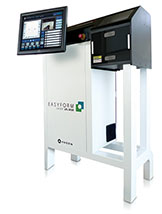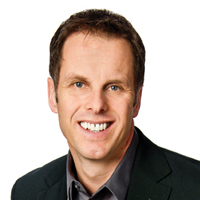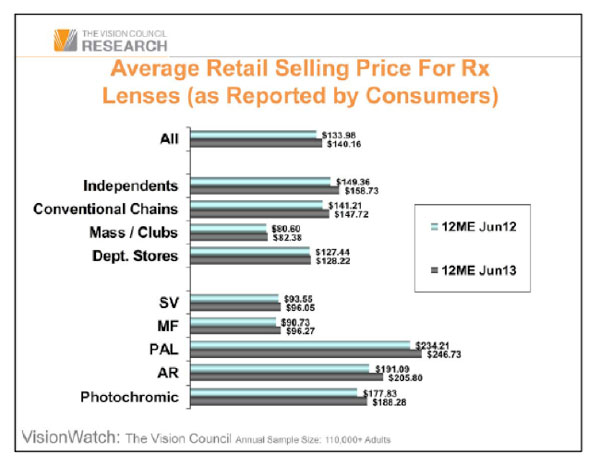Eye-trepreneurs
To Take Control of Its Lens Costs, 947-EYES Invested in In-House Digital Processing
 |
|
How 947-EYES Got Its Name
|
OKLAHOMA CITY, Okla.—With the rising costs of lenses shrinking profits at his four optical locations, Joe Madore of 947-EYES decided it was time to invest in an in-house free-form digital processing system. So, in 2011, he went to Vision Expo West in Las Vegas to find out what was available. After visiting the booths of all the companies with systems he had already heard of, he ended up with something unexpected, Augen Optics' EasyForm Digital Free Form Processing System.
"I liked the idea of owning my own software, owning my designs. That was my goal, getting my progressive costs down and buying my lenses for a buck a piece," Madore told dba about the reason he was willing to invest nearly half a million dollars to start producing his own digital lenses.
After considering some other potential equipment suppliers, he settled on Augen. "I have their whole free-form lab set up," he said "their generator, their blocker, their polisher, their laser engraver, their whole package."
At the same time, he also bought the Optikam system to take the measurements necessary to properly produce free-form lenses—vertex distance, pantascopic tilt, and frame wrap. "I decided I would do it right," he said about purchasing the extra measuring equipment.
Prior to installing the system, 947-EYES had been offering three different styles of progressive lenses, promoting them as good, better and best. By switching over to digital processing, he was able to eliminate the $70,000 worth of progressive inventory he previously had to keep in stock.
"Not only can I lock in my pricing on all the different designs and know what my costs will be five years down the road, but I can also be competitive using the newest technology to offer free-form for as low as $99 per pair to the consumer," he said.
He still offers his good lens, the standard, for $99, the better lens, the premium, for $149, and the best lens, the personalized, for $199, but now his costs are within his control and no longer subject to the whims of the lens companies that would lock in their prices for a couple of years but eventually begin raising them after a while.
"Every progressive we do is free-form," Madore told dba. "We're building a custom lens for each individual patient. I know it's working. We installed the system in February of 2012, and profit-wise it's absolutely paid off already."
   
|
|
Joe Madore of 947-EYES invested in Augen Optics' complete EasyForm digital processing system—the generator, blocker, polisher and lens engraving system. |
| Top | |
| Send your comments to VM |
dba q&a
How Regional Optical Retailers Are Benefiting from Social Media
|
|
As was once the case with having a company website, participating on social media platforms has gone from being optional to becoming a necessity of doing business. Facebook, Twitter, Yelp, YouTube and other sites have become a part of millions of consumers' daily lives, and optical retailers throughout the country have established their own profiles on these and other popular social media portals so that they too can participate in the conversation and drive business their way.
The following optical retailers told dba about their social media initiatives and listed their current social media platforms at the end of their answers: Daniel Stanton, CEO, Stanton Optical; Alan Ulsifer, OD, CEO and president, FYidoctors; Jonathan Rosin, M.D., co-president, Rosin Eyecare; Mark Johnson, director of optical services, Virginia Eye Institute; Timothy Gorin, VP, business development, MyEyeDr; and Jamie Erhardt, account supervisor, Emerging Vision, Inc.
 |
Timothy Gorin, VP, business development, MyEyeDr, Vienna, Va.
Which social media platforms have you been using since before 2013, added in 2013 and plan to add in the future? We have been very active using Facebook, Twitter and Yelp consistently for the past couple of years and recently added YouTube to the mix. Though we did have some pretty basic videos before this year on YouTube along with still images posted to Flickr, we did not have strong content designed to engage users. As part of a broader content marketing strategy, this year I produced some very unique branded videos which have been doing well for us, and we are in the planning stages of designing a new strategy to encourage even greater interaction. We especially like Love at First Sight, which is unlike anything else out there.
What benefits do you receive from maintaining these social media platforms? Not only have these platforms provided greater visibility and branding, but they help drive both our customer service and promotions. While both Facebook and Twitter are more about messaging and engagement, they are also sometimes forums for complaints. As a best practice we never delete negative reviews or complaints but rather use these as a way to reassure patients that we are listening and want to actively resolve any problems. This transparency and responsiveness vividly demonstrates our commitment to customer service. We also include some playful posts along with contests and giveaways, such as a summer concert series we do each year with a local music venue where we give away free tickets to musical performances.
For Yelp reviews, it is a key metric to help us drive traffic to our offices (click-to-brick) along with providing a way to identify problem areas along with an opportunity to engage in the online conversation. Every office has its own Yelp page, and we monitor each very closely.
What are the challenges to participating in these social media platforms? The biggest challenge is providing fresh and interesting content that does not feel "spammy." We realize retail optical is generally a low-engagement business and there is not a lot we can do to bring folks in more often than every 12 to 18 months, so we are very careful about what we post and how often. Yelp is in a category all its own, of course, and we take every review, especially the negative ones, very seriously. We take special care to respond to every review of three stars or less and work to turn everyone around by doing whatever it takes to resolve the situation. There are also some reviews which violate Yelp guidelines, and we submit those reviews directly to Yelp for removal.
Facebook:
facebook.com/MyEyeDr
Twitter:
twitter.com/MyEyeDr
YouTube:
youtube.com/user/MyEyeDrVideos
Yelp: (different links for each office)
 |
Jamie Erhardt, account supervisor, Emerging Vision, Inc., Melville, N.Y.
Which social media platforms have you been using since before 2013, added in 2013 and plan to add in the future? Sterling and Site for Sore Eyes added Facebook Ad Campaigns, Google+ and Wildfire Promotions in 2012. We had 357 submissions for Sterling's Mother's Day Giveaway. We also started including hashtags in posts—#SterlingSuggests and #opticalequipment.
What benefits do you receive from maintaining these social media platforms? We see social media as another way to connect with our customers and potential consumers. We get to respond to questions in real time, which makes for better customer service. We are also able to use the conversations that take place online as a learning tool for our stores. Additionally, social is a great channel to reach customers with sales, news and events.
What are the challenges to participating in these social media platforms? Response time. Social has set an expectation for its users that brands are online 24/7 waiting to respond. We have multiple people in place to make sure we are responding very quickly. Consumers want to feel heard, and we strive to make sure we're providing that level of service.
Site for Sore Eyes:
Facebook:
facebook.com/SFSEYES
Twitter:
twitter.com/siteforsoreeyes
Google +:
plus.google.com/108447515272679847985/posts
Sterling Optical:
Facebook:
facebook.com/SterlingOpticalStores
Twitter:
twitter.com/SterlingOptical
Google +:
plus.google.com/+sterlingoptical/posts
 |
Alan Ulsifer, OD, CEO and president, FYidoctors, Alberta, Canada
Which social media platforms have you been using since before 2013, added in 2013 and plan to add in the future? Before 2013 to present, we've used Facebook, Twitter and YouTube (to a smaller extent). We will be increasing our media spend on Facebook in 2014 and will be adding Pinterest.
What benefits do you receive from maintaining these social media platforms? Currently they only serve as (supportive) SEO tools at the moment (as we have a blog that casts out to our Facebook and Twitter accounts that is updated in real time on our RSS feed on our website). Down the road, we will encourage our patients to "follow" and "like" us and use Facebook as a tool to interact, communicate and stay "present" with our patients. We will also use it as a tool to drive brand awareness and ultimately as a tool to help drive new patient growth.
What are the challenges to participating in these social media platforms? In no particular order: full-time resources to devote to social media (including both strategy, insights and execution) and funds for add-on initiatives to drive growth/awareness. Getting clinics to understand the value of social media and getting them to encourage their patients to follow, like us, etc. Getting our clinics to understand the pitfalls of having fragmented social media (i.e. having their own Facebook pages) versus the value of having a corporate page with individual location pages (e.g. like Starbucks). As we have low brand awareness in general in Canada (as the majority of our clinics operate under their own names), we don't have a lot of customers "seeking" us on Facebook.
Facebook:
facebook.com/FYidoctors
Twitter:
twitter.com/FYidoctors
 |
Jonathan Rosin, M.D., co-president, Rosin Eyecare, Chicago
Which social media platforms have you been using since before 2013, added in 2013 and plan to add in the future? We embraced a social media campaign beginning in 2011 with Facebook and Twitter. With the help of a social media consultant, we designed campaigns to build "Friends" and then "Likes" on Facebook.
What benefits do you receive from maintaining these social media platforms? As our count increased, we began running Facebook advertisements with fairly strong calls to action. These were targeted to a very specific demographic that we identify as our core customer. Our overall experience was lackluster in terms of a dollar return on our investment although we did have a lot of fun seeing our "Likes" rise.
What are the challenges to participating in these social media platforms? The challenge is to be monitoring and responding to comments on Facebook and Twitter on a timely basis in order to foster the social nature of these sites. This turned out to be labor intensive. We also participated in two Groupons which were somewhat more successful from a dollar return on our investment but had little effect on our standing within the social media circles. At this point we believe that while social media efforts can be a lot of fun in terms of interacting with patients and prospective new customers, it is unreasonable to expect a large dollar return on the time and money that is required to stay relevant.
Facebook: facebook.com/Eyecare
 |
Daniel Stanton, CEO, Stanton Optical, Palm Springs, Fla.
Which social media platforms have you been using since before 2013, added in 2013 and plan to add in the future? Prior to 2013, Stanton Optical was using Facebook, Twitter, LinkedIn and Google+. The social media sites were not being updated on a regular basis. In January 2013 we hired two new people in our marketing department. In addition to writing content for web pages, press releases and blog articles, our new SEO copywriter was tasked with keeping all our social media sites updated with fresh content. New social media sites for 2013 include Pinterest, Tumblr and Instagram. Our content writer uses HootSuite to schedule daily posts to Twitter, Facebook and Google+. Pinterest and Tumblr are updated weekly. Instagram is fairly new to us and not being used that much, but we plan to use it in the future for online photo contests, etc.
What benefits do you receive from maintaining these social media platforms? Our LinkedIn account is used for B2B connections and updated one to three times per week. All our other social media accounts are used for B2C communications. We are looking for key influencers and brand ambassadors via our various social accounts. It is time-consuming, but we are starting to connect with some of our fans and followers.
What are the challenges to participating in these social media platforms? Our biggest challenge is finding time to research and post new and interesting content to all our social media marketing sites. We were using additional social sites but that proved to be too time consuming to keep them updated. We find it's a better use of our time to post better content to fewer sites. Besides the Facebook page for our corporate store in Palm Springs, Fla., we also have individual pages for each of our 30 Stanton Optical stores. While we will continue to update our main Facebook page and other social media sites in house, we just hired an outside marketing firm for help keeping the content fresh on the individual store pages.
Facebook:
facebook.com/StantonOptical
FourSquare:
foursquare.com/stantonoptical1
Google+:
plus.google.com/+stantonoptical/posts
Instagram:
instagram.com/stantonoptical
LinkedIn:
linkedin.com/company/stanton-optical/
Pinterest:
pinterest.com/stantonoptical
Tumblr:
stantonoptical.tumblr.com/
Twitter:
twitter.com/stantonoptical1
YouTube:
youtube.com/user/StantonOpticalHQ
 |
Mark Johnson, director of optical services, Virginia Eye Institute, Richmond, Va.
Which social media platforms have you been using since before 2013, added in 2013 and plan to add in the future? Since 2011 we have been utilizing Facebook, Twitter and YouTube. These social media sites have been very beneficial for Virginia Eye Institute as they are great tools to get information out about new products, new sites, new doctors and activities. In the future we plan to look at many others with our marketing firm to see which ones will be a great fit for VEI.
What benefits do you receive from maintaining these social media platforms? We have found it a great way to get information out about new sites, doctors, events and promotions. Social media is an efficient and inexpensive way to market a practice and reach tens of thousands of people very quickly. It is also very exciting and fun to get something to go viral, which gives you the feedback of what interests different groups of people.
What are the challenges to participating in these social media platforms? It is important for any practice to consider having a policy in place on how different things are handled with the practice's social media sites. This policy should have different components such as who is responsible for keeping it updated, what type of content is posted and how different interactions are handled.
We always must remember that social media is an interactive tool for both the host and visitor. It is important to keep it positive and do your best to turn every negative comment into a positive one. For example, a patient may post a complaint on your Facebook page. The practice will have to make a decision on how the complaint is replied to. You will have the option to reply via another posting on Facebook or contact the patient directly. There could be benefits to both ways of replying. If your reply to the patient complaint/concern is educational it could benefit everyone to post it.
The biggest challenge of utilizing social media is keeping it updated and fresh. You want to keep your followers interested. Look at other businesses' social media pages for ideas. Think outside of the box!
Facebook: facebook.com/VirginiaEyeInstitute
| Top | |
| Send your comments to VM |
eMedia
Construction Management Software Helps Eyemart Express Keep Adding Locations

|
FARMERS BRANCH, Texas—While Eyemart Express has maintained its ranking as the seventh largest U.S. Optical retailer over the past few years (according to Vision Monday's annual Top 50 U.S. Optical Retailers report), each year it consistently adds new locations. The Top 10 U.S. optical retailer went from 102 locations in 2009 to 130 in 2010 then grew to 135 locations in 2011 and 141 in 2012.
With locations across 30 states and still growing, Eyemart Express has now enlisted the use of Projectmates construction management software to manage its increasing number of retail locations and take its construction management program to the next level.
"Projectmates will help us save time in the sense that everything is centralized," said Tom Wentz, senior vice president of design and construction. Wentz said Projectmates' user-friendly software sets it apart from other construction management software he's seen.
Eyemart Express will be able to overcome current challenges in the construction process by using Projectmates to keep track of project costs, track and award bids, and manage the punchlist from the field using iPads and other tablet devices.
"Projectmates will be a lot quicker and easier to use when in the field," Wentz said. He's particularly encouraged about the punchlist feature because people can access it from the field.
With Projectmates for Retail, Eyemart Express can better keep up with workflow processes, check tasks and add photos from the field. Everyone from store operations and merchandising to human resources all play a part in getting a store open, so it was important for Eyemart Express to select a software system that is accessible by all project team members.
Projectmates is 100 percent cloud-based, which allows the owner, contractor, architect, and other project team members to collaborate on a common platform.
Founded in 1995 by architects and software engineers, Systemates developed Projectmates to provide owners with a project management construction software solution. Projectmates creates one seamless platform for managing the complete lifecycle of a building, from planning, bidding, and building to maintaining the facilities. For Eyemart Express, the software program saves time and makes the construction management process quicker and easier.
| Top | |
| Send your comments to VM |
Visionstructions
Step Up and Stand Out By Giving Back to the Community
With all the juggling we do every day it is very easy to forget about our responsibility to participate and contribute to our community. Altruism not only provides you with a sense of enrichment knowing that you have positively impacted the lives of those around you, but it can also help to support your business goals as well.

There are many examples of organizations that support activities in your community. These include the Kiwanis Club, the Lions Club and CancerCare. There are also a wide variety of causes specifically geared toward the optical community. For example, many practices and eyecare and eyewear providers participate in the annual World Sight Day sponsored by Optometry Giving Sight. Some practices support their own causes such as Crown Vision which sponsors Kids Vision for Life to provide free vision screenings, free eye exams, and free eyeglasses to children in the St. Louis Public School System.
I personally joined the Kiwanis Club because their focus is very close to my own. They place kids as a top priority, and they have a Safe Haven for Kids Zone program as well. With the Kiwanis, we feed the homeless and give out turkeys to those in need for Thanksgiving. Furthermore, they provide scholarships for kids and send less fortunate kids to Kiwanis Camp each summer.
Get All of Your Locations Involved
The Kiwanis is just one group; there are many organizations that will provide you with the ability to support local programs. The point is to participate. Let the managers of each of your locations go to meetings, get involved and make it a part of your company mantra. Adopt a program that is supported by your entire team every day. Assign leaders to both train your teams and implement strategies that support the program you've selected. They can be your in-house community advocates.
Another big perk is that your location managers will meet all the local business owners, politicians, school principals and bank managers. After going to monthly meetings, most of these folks became our patients, and the referrals are tremendous.
Set up a plan to inform your patients using promotional materials, social media and your website. Ask them to help you achieve your goals as well. You will be amazed at how much folks would love the opportunity to join in, not to mention the appreciation they will have for you and your team.
One way to provide community service is through an event. You can join a large fundraising event such as the Pan-Mass Challenge or a local CancerCare bike ride or walk. Recently there was a bike ride from Boston to New York City over a weekend. Many teams were created, and many companies sponsored the teams. Teams can be as little as five people or as large as hundreds. You can set up your own team of riders and/or collaborate with some of your patients to join your team too. The more locations you have, the larger your team can be. The more the merrier!
Choosing a Cause That's Right for You
Every year, non-profit organizations solicit companies hoping to obtain much needed funding to help others. Many businesses are willing to give but are often confused as to which causes are best.
Here are some quick tips for helping your business choose the right charities to support:
- Understand your business' values. Start with your mission statement. Use this to assess the connection between your practice and a charity.
- Who else is donating? Find out from your staff and patients which causes and non-profits they support. Identify what is important to them.
- Determine the charity's impact potential. Consider certain factors such as the size of the charity, the age of the organization and whether the charity will do its work locally, nationally or internationally.
Get the Word Out
Once you choose an organization, get the word out to the community. Not only will it help with fundraising, but it will also let the community know what you're doing.
Social Media
- Facebook: Each week, post the latest update on someone's training. Include pictures. Let everyone know how close you are to the goal.
- Twitter: Post updates leading up to the event and on the day of the event.
- Blog: Each week, write about a new employee or patient and their connection to the cause.
- Website: There should be a new page on your website and a link on the homepage pointing your patients to information about what you're doing for the community and how they can get involved and even join your team.
In Office
- Design a donation box to have at your front desk, waiting areas and or dispensing and check-out stations. After you adjust their glasses or change their nose pads many patients ask, "How much do I owe you?" Typically there is no charge, but instead, you can say, "We're supporting cancer research; feel free to donate some change into the jar."
- Dollar Match? Have your staff trained to let patients know about your initiative, and let them ask for one dollar to be added to their statement. (Program it into your computer.) Be sure to let patients know that you are going to match every dollar!
One very creative way an office raised money and created a huge dose of goodwill was by creating a cure cancer frame board. The frames with a pink ribbon were free with the purchase of lenses as long as they made a donation to the cause. It could be as little as $1.00. Surprisingly, many patients were very generous and actually gave more than the frame would have sold for in the first place. Talk about a relationship builder!
If you don't want to sponsor an event where your employees, managers or family members attend, another good option is to donate frames and lenses. Explore organizations that provide food and clothing to the needy and join in with a quarterly event to provide an examination and basic frame and lenses. Provide refreshments and gifts, take pictures to celebrate and post them to your social media and website.
I am sure we can all resource worthwhile local community needs to support. There are no shortages of these…only shortages of those who support them. Get in touch with your local politicians and find out what difficulties the community is having. Collaborate with them and adopt a cause. Getting involved is personally rewarding on so many levels. As a multi-location business, your ability to have an impact is tremendous, not to mention establishing yourself as a trusted and respected business resident of the community.

Jay Binkowitz, optometric business consultant, is chief executive officer and president of GPN, exclusive provider of The EDGE.
 |

Evan Kestenbaum, MBA, is chief information officer of GPN, Exclusive Provider of The EDGE. Contact Jay and Evan directly at clientservices.gpn@gmail.com.
| Top | |
| Send your comments to VM |
dataPoint
Prescription Lens Prices Up 4.6 Percent or $6.18 Per Pair for Year Ending June 2013
Total retail prescription lens prices were up 4.6 percent during the 12-month period from July 1, 2012, to June 30, 2013, when compared to the same period a year prior, according to The Vision Council's latest VisionWatch statistics. That represents an increase of $6.18 per pair. Lens prices have been increasing for about 3.5 years now, with prices climbing sharply over the past six quarters, according to the report. In addition, total Rx lens prices during the June 2013 period were higher than they were before the recession started, up by 7 percent when compared with prices from the 12-month period ending June 30, 2008.
Lens prices were up the most among independent ECP retailers (+6.3 percent), which was mostly the result of a rise in prices for existing products but also influenced by an increase in sales of higher quality, higher priced lens products such as free-form digitally surfaced progressive addition lenses, high index lenses and premium anti-reflective lenses, the report stated. Prices have increased for single vision, multi-focal and progressive lenses, with multi-focal prices rising the most (6.1 percent) during the 12-month period ending June 2013, after declining slightly for a few years.
Prices for anti-reflective lenses and photochromic lenses were also up over the past year, with anti-reflective lenses seeing the largest increases (5.9 percent) due to a rising number of high index lenses and progressive lenses being sold with AR, according to the VisionWatch statistics. While prices of progressive lenses have increased significantly over the past year (+5.3 percent), they had also been increasing steadily for the past few years, even during the recession. Retail prices for progressive addition lenses are up by almost $30 per pair when compared to 2008.
The Vision Council's VisionWatch statistics are based on a large-scale consumer research study that interviews a demographically balanced sample of more than 110,000 American adults every year.

|
|
Source: The Vision Council's VisionWatch Second Quarter 2013 U.S. Optical Market Overview and Outlook for the one-year period from July 1, 2012 to June 30, 2013. |
| Top | |
| Send your comments to VM |
